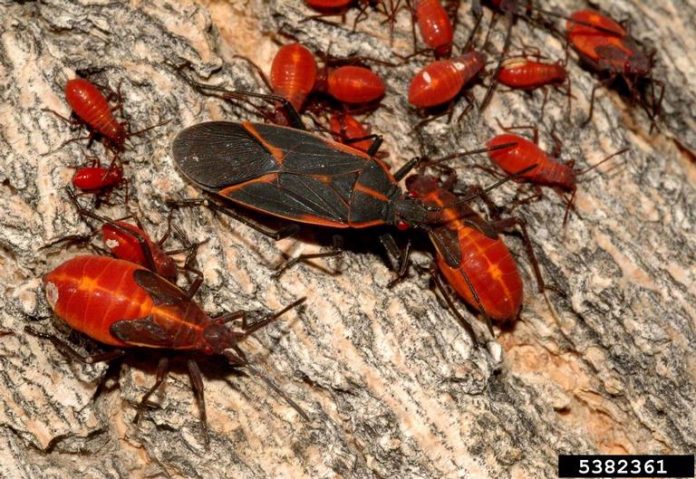
Cedric Gillott
With the return of warm, sunny weather, we have seen the emergence of huge numbers of adult boxelder bugs (also called maple bugs) from their overwintering sites. Initially, they accumulate where they can enjoy the benefit of the warming sun, especially therefore on south-facing structures such as tree trunks and (unfortunately) the walls of houses and other buildings. At this stage, their preferred host (boxelder, aka Manitoba maple) has not begun to leaf out so resting in the sun is a means of conserving energy.
By early May, boxelder will have produced either male or female flowers. (Boxelder is very unusual among plants in that it is dioecious; that is, it has distinct male and female individuals.) Almost simultaneously with flowering, the trees begin to leaf out and it is at this point that the boxelder bugs migrate to the newly available food source. Female boxelder bugs strongly prefer female trees, laying their eggs adjacent to the developing flowers from which seed capsules are produced. This habit, which provides the growing young with a readily available food source, may have evolved because the sap of the seed capsules is a richer food source than the sap from foliage, though this is speculation on the writer’s part.
Within a few weeks, the eggs will have hatched, giving rise to multitudes of tiny, bright red nymphs. As they develop, the nymphs will moult five times, gradually becoming more adult-like, most obviously in the development of the black wing buds, within which the adults’ wings are produced. Whether by accident or design, these older nymphs can often be seen on the ground (e.g., in lawns), presumably feeding on the sap from other plants to complete their growth. New season adults will be evident by early August. These will reach sexual maturity and mate before searching for overwintering sites as the days shorten and weather cools off in September. Favored overwintering places include leaf litter and under loose bark, and in tree trunk cracks and crevices. Unfortunately (from a human perspective!), the bugs’ search for a place to spend the winter sees them collecting in large numbers on south- and west-facing surfaces where they locate entry points to buildings, attracted by heat escaping from leaks around doors, windows, vents, etc.
Though it’s little consolation to homeowners in central and southern Saskatchewan, it’s worth noting that boxelder bug populations are currently also booming in southeastern Alberta and southern Manitoba, following the natural distribution of their preferred host. However, the wide use of boxelder as a shade/boulevard tree in urban areas and on farmsteads has enabled boxelder bugs to widen their range in recent decades.
The boxelder bug population boom that we are currently experiencing is not unusual among insects (grasshoppers are another group that show this tendency). Population numbers rise and fall, usually in cycles that last 5 to 7 years; but, the duration of a cycle is very dependent on climatic conditions. Thus, our recent hot, dry summers, combined with the relatively mild winters that we have experienced, have been ideal for the boxelder bugs’ current survival and reproductive success. Few birds appear to feed on boxelder bugs, presumably because like a well- known cough medicine they “taste awful”. Similarly, they appear to be prey for very few insects. However, it should be noted that little research has been done on boxelder bugs’ natural enemies (predators, parasites and pathogens), presumably because the bugs are considered merely as a nuisance pest with no economic importance.
Of course, the million-dollar question from home owners is “What can be done to get rid of these smelly pests that leave their excreta everywhere?”. Sadly, the simple answer is “Nothing”. Outdoors, some temporary satisfaction may be gained by the application of a commercial insecticide or a home-made spray such as a dilute soap solution. However, the result will just be transient, as more individuals will quickly recolonize the space. Where boxelder bugs find their way indoors, prevention is better than cure; that is, seal joints around windows, doors, and vents for driers, air conditioners, etc. If a few bugs still gain entry, simply kill them with a fly swatter. For larger numbers, get out the vacuum cleaner!
Cedric Gillott is a retired entomologist and professor emeritus in the Department of Biology at the University of Saskatchewan.This column is provided courtesy of the Saskatchewan Perennial Society (SPS; saskperennial@hotmail.com). Check our website (www.saskperennial.ca) or Facebook page (www.facebook.com/saskperennial) for a list of upcoming gardening events.
